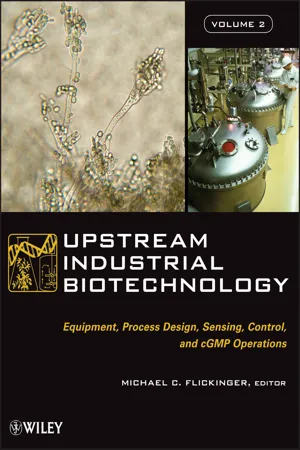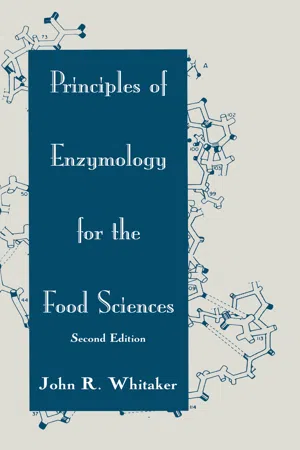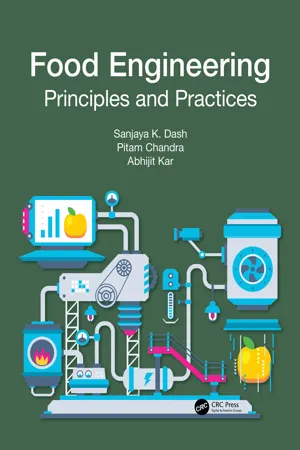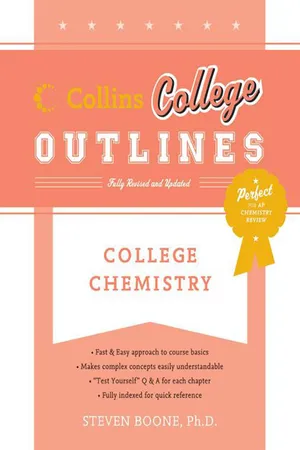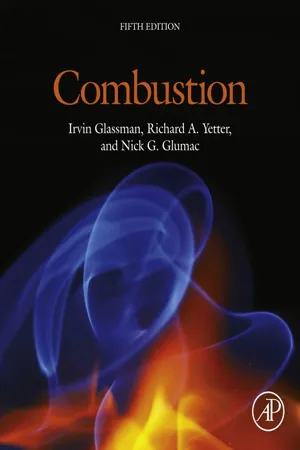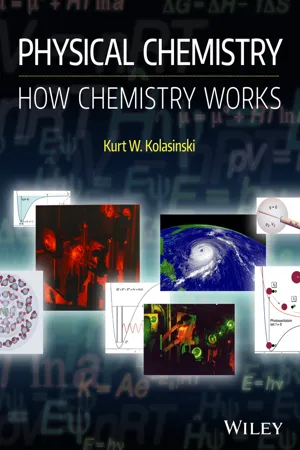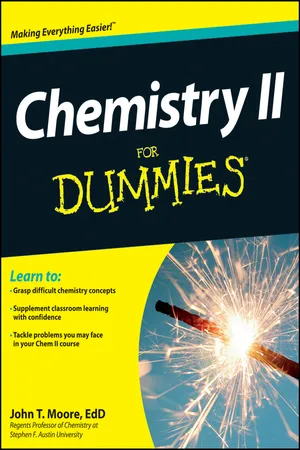Chemistry
Second Order Reactions
Second order reactions in chemistry refer to chemical reactions where the rate of the reaction is directly proportional to the square of the concentration of one reactant or the product of the concentrations of two reactants. These reactions are characterized by their rate laws, which typically follow the form rate = k[A]^2 or rate = k[A][B]. The overall order of the reaction is 2.
Written by Perlego with AI-assistance
Related key terms
Related key terms
1 of 4
Related key terms
1 of 3
8 Key excerpts on "Second Order Reactions"
- eBook - ePub
- Michael C. Flickinger(Author)
- 2013(Publication Date)
- Wiley(Publisher)
pseudo first-order reaction. Some reactions are observed to be of the zero order, that is, the rate appears to be constant, independent of the concentration of reactant. This is a characteristic feature of catalyzed reactions and occurs if reactant is present in such large excess that the full potential of catalyst is realized.Table 17.3 Molecularity of Chemical Reaction17.3.2 Dimensions of Rate Constants
Knowledge of dimensions is very useful to check the correctness of derived kinetic equations: the left- and right-hand sides of equations must always have the same dimensions. This general rule is applicable to all mathematical models (not only in chemical kinetics). It is incorrect to add or subtract terms of different dimensions, although you may multiply or divide them. For example, if expression “ … (1 + s)” occurs in an equation, where s has dimension (concentration), then either it is incorrect, or the 1 is a concentration that happens to have a numerical value of 1 unit. The operation rising to power is allowed for only simple dimensionless numbers, for example, expression e2.5t, where t is time, is correct only if 2.5 has dimension (time)−1 . The comparison of velocities of two reactions does make any sense only for kinetic terms of the same dimension. If the kinetic order of inspected reactions is different, then we have to equalize the respective rate of expressions; for example, the second-order rate constant k (time)−1 (concentration)−1 should be multiplied by instant concentration of reactant s to be compared with the first-order rate constant having dimension (time)−1 . The dimensions of the zero-, first-, and second-order rate constants are shown in Table 17.4 - eBook - ePub
- John R. Whitaker(Author)
- 2018(Publication Date)
- Routledge(Publisher)
5). The individual rate constants are calculated by recourse to Eq. (51). C. Second-Order Rate Laws A second-order rate process is characterized by the rate being dependent on two molecules either of the same compound or of two different compounds. Consider the reaction described by Figure 5 First-order reversible rate process. The line is drawn according to Eq. (54). The slope of the line is the sum of the forward and reverse specific reaction rate constants. A + B → k P (55) The rate of the reaction may be written as − d A d t = − d B d t = d P d t = k (A) (B) (56) Experimentally, we can distinguish three types of second-order reactions and the forms of the integrated rate expressions will be dependent on the type. 1 Type I Type 1 second-order reactions will be designated as those in which the initial concentrations of A and B are identical and in which the two react in equimolar amounts. In this case Eq. (56) may be written as − d A d t = k (A) 2 (57) Integration between the limits of A 0 and A at times t 0 and t, − ∫ A 0 A d A (A) 2 = k ∫ t 0 t d t (58) gives − [ − 1 (A) + 1 (A 0) ] = k t − k t 0 = k t (when t 0 = 0) (59) which rearranges to the. form (A 0) − (A) (A) (A 0) = k t = (P) (A 0) [ (A 0) − (P) ] (60) A plot of data according to Eq. (60) gives a straight line with intercept of zero and slope of k provided that the reaction is type I second order (Fig. 6). The half-life, t 1/2, of the reaction is calculated by using the relation (A) = 0.5(A 0), and thus Eq. (60) becomes t 1 / 2 = 1 k (A 0) (61) The half-life of a second-order reaction (type I) depends on the initial concentration of the reactant, but the half-life of a first-order reaction does not. This provides a simple experimental method of distinguishing between the two. 2 Type II Type II second-order reactions will be designated as those in which the initial concentrations of A and B are not equal but are similar. In actual practice this is when (B 0)/(A 0) > 1 < 20 - eBook - ePub
Food Engineering
Principles and Practices
- Sanjaya K. Dash, Pitam Chandra, Abhijit Kar(Authors)
- 2023(Publication Date)
- CRC Press(Publisher)
It is an overall third order reaction, a + b = 3. As mentioned, third order reactions are rare.4.1.6 Other Orders of Reactions
As in a bimolecular reaction between adsorbed molecules, with respect to a reactant, reactions can have an undefined order.The concentration of that reactant remains constant, which is in great excess as compared to other reactants; however, a pseudo constant is obtained, and its concentration is included in the rate constant. If the reactant having constant concentration is B, thenr = k[A]a [B] = k′ [A]a (4.32)The situation is also true if there is a catalyst in the reaction as the concentration of catalyst does not change in the reaction. Here, a pseudo first order rate equation is obtained for the second order rate equation. This is why it will be more appropriate to take the conversion of sucrose into glucose and fructose as a pseudo first order reaction.The hydrolysis of esters by dilute mineral acids is an example of a pseudo first order reaction as excess amount of water is involved in the reaction.CH3 COOCH3 + H2 O → CH3 COOH + CH3 OHThe approximation of pseudo first order reaction has another practical utility. For example, the measurement of a second order reaction rate is difficult since the concentrations of the two simultaneously changing reactants need to be monitored. In this situation the pseudo first order approximation can be taken.As mentioned before, the orders of reactions can be non-integers also. For example, the order of the reaction of the decomposition of ethanol to methane and carbon monoxide is 1.5 with respect to ethanol. Such reactions are known as broken-order reactions. - No longer available |Learn more
- Steven Boone, Drew H. Wolfe(Authors)
- 2011(Publication Date)
- Collins Reference(Publisher)
To obtain the dependence of concentration on reaction rate, the instantaneous rate is measured for different starting concentrations. The instantaneous rate is approximated by measuring a concentration change over a short time period at the very beginning of the reaction. From these data, the rate expression is derived. For example, if compound A decomposes to products, A → products, a rate expression with the following form is derived.In this rate expression, or rate law equation, k , is the rate constant, [A] is the molar concentration of A, and x is the reaction order. Because [A] decreases and the reaction rate is always positive, the sign is in the rate law equation.Reaction OrdersThe exponents of the concentration terms in the rate law are termed the reaction orders. When the molar concentration of A is raised to the first power, the reaction is said to be first order with respect to A. If the molar concentration of A is raised to the second power, the reaction is said to be second order with respect to A. If a reactant is first order, when its molar concentration doubles, the initial instantaneous rate doubles. If the concentration triples, the reaction rate triples.Instantaneous rate ∞ [A]1However, if the reaction order with respect to the reactant is second order, the reaction rate increases four times, 22 , when the concentration doubles and increases eight times, 23 , when the concentration triples.Instantaneous rate ∞ [A]2Overall Reaction OrdersFor reactions that have more than one reactant, the sum of the reaction orders in the rate law equals the overall reaction order. For example, consider the following rate expression for the reaction, A + B → products.The overall reaction order equals is the sum of the exponents, x + y . Thus, if x = 1 and y = 2, the overall reaction order equals 3, which is a third-order reaction. This means if the molar concentrations of both reactants doubles, the rate of the reaction increases eight times, 21 × 22 23 - eBook - ePub
- Irvin Glassman, Richard A. Yetter, Nick G. Glumac(Authors)
- 2014(Publication Date)
- Academic Press(Publisher)
represents not only the overall order of the reaction but also the molecularity, which is defined as the number of molecules that interact in the reaction step. Generally the molecularity of most reactions of interest will be 2 or 3. For a complex reaction scheme, the concept of molecularity is not appropriate, and the overall order can take various values including fractional ones.The convention used throughout this book is that parentheses around a chemical symbol signify the concentration of that species in moles or mass per cubic centimeter. Also note that the molar concentration of a species Mj can be related to the mole fraction of that species through the ideal gas equation of stateXj P= (M j)RT .2.2.1. The Arrhenius Rate Expression
In most chemical reactions, the rates are dominated by collisions of two species that may have the capability to react. Thus, most simple reactions are second-order. Other reactions are dominated by a loose bond-breaking step and thus are first-order. Most of these latter type reactions fall in the class of decomposition processes. Isomerization reactions are also found to be first-order. According to Lindemann's theory [1 ,5 ] of first-order processes, first-order reactions occur as a result of a two-step process. This point will be discussed in a subsequent section.An arbitrary second-order reaction may be written aswhere a real example would be the reaction of oxygen atoms with nitrogen molecules:A + B → C + D(2.4)O +N 2→ NO + NFor the arbitrary reaction (2.4) , the rate expression takes the form− R R == − kd ( A )d t( A )( B )== −d ( B )d t= −d ( C )d td ( D )d t(2.5)Here, the termwhich is present in Eqn (2.3) , is − 1 for the rate expressions of species A and B and 1 for the rate expressions of species C and D. Specifying the reaction in this manner does not infer that every collision of the reactants A and B would lead to products or cause the disappearance of either reactant. Arrhenius [6] put forth a simple theory that accounts for this fact and gives a temperature dependence of k . According to Arrhenius, only molecules that possess energy greater than a certain amount, E(,)ν j ″−ν j ′ - eBook - ePub
- Pieter Walstra(Author)
- 2002(Publication Date)
- CRC Press(Publisher)
4 Reaction Kinetics
Chemical kinetics is generally discussed with respect to reactions between molecules (or ions or radicals) in a gas phase or in a very dilute solution. In foods, we often have other situations. The system never is gaseous, it is rarely very dilute, and it may have more than one phase containing reactants. Changes may occur within molecules, especially macromolecules. Reactions may be between particles, causing, for instance, their aggregation. Numerous other changes may occur, such as phase transitions, leading to a change in rheological properties, color, or other perceptible property. In nearly all such cases we are greatly interested in the rate at which these processes occur. This we cannot derive from the bond energies involved or from other thermodynamic considerations: these may tell us what the driving force is, but in general the rate results from a driving force divided by a resistance, and the resistance may be very large or highly variable.In this chapter, we will recall some basic aspects of chemical reaction kinetics in solution, starting from an oversimplified point of view and gradually bringing in more complications. We will not discuss theory aimed at explaining reaction rates on a molecular level (molecular reaction dynamics). Other rate processes will be discussed in Chapters 5 and 13 .4.1 REACTION ORDER
Before coming to factors determining reaction rates, it is useful to review the manner in which concentrations depend on time.The reaction rate is usually given as the change in concentration c, i.e., as either + or -dc/dt. According to the units of c, it may be expressed in mol·L-1 ·s-1 (the most common way), mol·kg-1·s-1 , number ·m-3·s-1 , etc.For a zero-order reaction, the rate remains constant: see Table 4.1 - eBook - ePub
Physical Chemistry
How Chemistry Works
- Kurt W. Kolasinski(Author)
- 2016(Publication Date)
- Wiley(Publisher)
CHAPTER 16 Empirical chemical kineticsPREVIEW OF IMPORTANT CONCEPTS
- A rate law relates concentration to time in terms of the concentrations of the species involved in the reaction. The differential form describes the rate of change of concentration with respect to time. The integrated form describes concentration as a function of time.
- We need to differentiate between elementary reactions (ones that occur in a single step) and composite reactions (ones that are composed of a series of elementary steps).
- For an elementary reaction, the kinetic order of reaction is always the same as the molecularity, the partial order with respect to a specific reactant is the same as its stoichiometric coefficient, and products do not appear in the rate equation.
- The kinetic order of a composite reaction is not directly related to the stoichiometry of the balanced chemical reaction.
- A reaction mechanism is a series of elementary reactions that adds up to the stoichiometry of the composite reaction.
- A rate-determining step is the elementary step in the reaction mechanism that has the greatest influence on the reaction rate.
- The rate constant is a positive number, the units of which depend on the reaction order. Many rate constants exhibit Arrhenius behavior, which means they have a temperature dependence given by the Arrhenius equation.
- Thermodynamics determines the concentrations of reactants and products at equilibrium. Kinetics describes the rate of evolution of a system. It determines how long it takes for a system to achieve equilibrium, if at all.
- Collisions almost invariably precede reaction, and the collision rate represents an upper limit to the rate at which a reaction can occur.
- Only collisions that have sufficient energy and which satisfy the proper geometry lead to reaction.
16.1 What is chemical kinetics?
Chemical kinetics is the measurement and description of the rates of chemical reactions. It seeks to develop mathematical equations that describe and predict the course of chemical reactions in terms of the species involved in the reaction. The mathematical equations are called rate laws - eBook - ePub
- John T. Moore(Author)
- 2012(Publication Date)
- For Dummies(Publisher)
The 1 order of reaction for the ozone is understood. This is the same rate law that you can arrive at by logic. In most situations, especially in the lab, you need to solve for the orders of reaction mathematically.The overall order of this reaction is the sum of the individual orders (m + n ). In this case it would be 2 + 1 = 3; the reaction is third order overall.Finding the rate constantAfter determining the orders of reaction, determining the rate constant is rather easy. You simply choose any one of the three experiments and substitute in the rate, the concentrations, and the orders of reaction. Then you solve for k .The rate expression so far is:Rate = k [NO]2 [O3 ]Choose Experiment 1 and substitute in all the values:0.5 M/s = k (0.1 M)2 (0.1M)0.5 M/s = k (0.01M2 )(0.1 M)0.5 M/s = k (0.001 M3 )Told you it was easy! Grasping Integrated Rate LawsThe rate law that you determined in the previous section is just the first step in studying kinetics of a reaction. The next step is to make use of an integrated rate law. An integrated rate law describes how the concentrations relate to changes in time. The integrated rate law allows you to determine when a reaction is complete, or how much of a product can be produced per minute/hour/day. Using an integrated rate law allows a medical doctor to know when a patient needs a new dose of a medication. These are but a few of the applications of integrated rate laws.Many types of integrated rate laws exist, but I limit my discussion to reactions in the following sections to ones such as this:A → Bwith rate laws containing only one reactant (A) and an order of 1, 2, or 0. That is, I only consider the following rate laws in these sections:First order: Rate = k [A]1Second order: Rate = k [A]2Zero order: Rate = k [A]0First orderI start with a first order rate law (Rate = k [A]1
Index pages curate the most relevant extracts from our library of academic textbooks. They’ve been created using an in-house natural language model (NLM), each adding context and meaning to key research topics.
Explore more topic indexes
Explore more topic indexes
1 of 6
Explore more topic indexes
1 of 4
